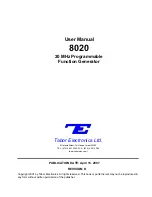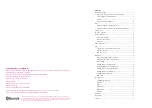
Page 12 H0 Sound Decoder MX640
CV
Designation
Range
Default
Description
#64
Light effects
modifications
0 - 9
5
Ditch light off time modification
0, 1
0
#133
For fan
control
from
SW
version
4
Function output 4 as
virtual cam sensor
for external
sound modules
or
FO4 as output for a
smoke generator
fan.
200 - 255
= 0 (Default): FO4 is used as normal function
output, not as virtual cam sensor.
= 1: FO4 supplies cam sensor pulses, either
from the virtual or real cam sensor.
See CV #267 and 268!
= 200 – 255: The steam fan of a smoke
generator is connected to FO10. If the
smoke generator itself (heating ele
ment) is defined as a “Special Effect” in
one of the CV’s #125 - 132 as
= 72 or
= 76 for a steam engine or
= 80 or
= 84 for a diesel,
the fan (FO10) will be actuated with
the function key for the smoke
generator (heater) – which is the one
that is assigned for the “Special
Effects” output
and
- is synchronized with the steam
chuffs in case of steam engines
- is activated when the motor’s start-
up sound is played back as well as
under load.
For diesel engines, the value behind
the “2” (0 – 55) is the time the start-up
smoke should be delayed from the
start-up sound.
#134
Asymmetrical
threshold for
stopping with
asymmetrical DCC
signal (Lenz ABC
method)
1 - 14,
101 - 114,
201 - 214
=
0,1 - 1,4 V
106
Hundredths digit: Sensitivity adjustment,
changes the speed with which the asymmetry
is being recognized.
= 0: fast recognition (but higher risk of errors,
i.e. unreliable stopping.
= 1: normal recognition (@ 0.5 sec.), pretty
save results (default).
= 2: slow recognition (@ 1 sec.), very reliable.
Tenths and ones digit: Asymmetrical threshold
in tenths of a volt.
This voltage difference between the half waves
of the DCC signal is the minimum required to
be recognized as asymmetrical that starts the
intended effect (usually braking and stopping of
a train). Also see CV #27!
= 106 (Default) therefore means 0.6 V. This
value has proven itself to be appropriate under
normal conditions; by using 4 diodes to gener-
ate the asymmetry, see chapter 4!
1
CV
Designation
Range
Default
Description
#135
km/h –
Speed regulation -
Activating, control
and range
definition
2 – 20
0
= 0: km/h – Regulation turned off; the “normal”
speed regulation is in effect.
Start with Pseudo-Programming („Pseudo“ =
programmed value is not being stored):
CV #135 = 1 -> Initiates a calibration run
(see chapter 4, „km/h – speed regulation“)
Continue with “normal“ programming of
CV #135 (programmed value will be stored):
= 2 to 20: speed steps / km/h – factor; e.g.:
= 10: each step (1 to 126) represents
1 km/h: that is step 1 = 1 km/h,
step 2 = 2 km/h, step 3 = 3 km/h,
= 20: each step represents 2 km/h;
step 1 = 2 km/h, step 2 = 4 km/h,
last step 126 = 253 km/h.
= 5: each step represents
.
5 km/h;
step 1 =
.
5 km/h, step 2 = 1 km/h,
last step 126 = 63 km/h.
See chapter 4, „km/h – speed regulation“!
#136
km/h –
Speed regulation -
Control number
read-out
- -
A numeric value can be read-out after a suc-
cessful calibration run, which was used to cal-
culate the speed. This value is interesting be-
cause it is (almost) independent from the se-
lected speed during the calibration run. The
uniformity of the resulting values from several
calibration runs may be an indication of the
calibration quality. See chapter 4!
From
SW
vers 4
#137
#138
#139
Characteristic curve
of a smoke
generator
connected to one of
the FO’s 1 – 6 (for
which a “smoke ef-
fect” is selected in
the associated CV
#127 – 132).
PWM at standstill
PWM at minimum
speed
PWM at maximum
speed
0 - 255
0 - 255
0 - 255
0
0
0
The three values in CV’s #137 – 139 define a
characteristic curve (FO1, FO2, FO3, FO4,
FO5 or FO6, below as FOx) for the function
output that is defined in CV #127 – 132 for a
“smoke effect” of a steam or diesel engine, i.e.
72, 76, 80 or 84.
If Bit 0 in CV #112 = 0; Characteristic is speed
dependent (nominal value):
CV #137: PWM of FOx at stand still
CV #138: PWM of FOx at speed step 1
CV #139: PWM of FOx at highest speed step
If Bit 0 in CV #112 = 1; Characteristic is load
dependent:
CV #137: PWM of FOx at stand still and when
braking
CV #138: PWM of FOx at speed step 1
CV #139: PWM of FOx at highest speed step,
when accelerating and under high
load.













































